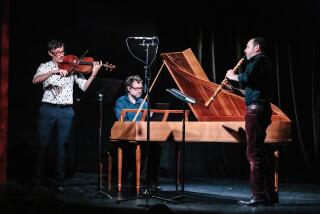It’s about the music, so cool it with the camera work
Watching a music performance on video in the MTV years has become an annoying experience. Why? Because batteries of mobile cameras combined with a sophisticated array of picture-modifying techniques have provided directors the power to completely control the images.
As a result, it is the picture rather than the music that has become primary in most performance presentations. Cameras are in almost constant motion, long shots are quickly replaced by close-ups followed by audience reaction shots followed by overhead boom shots. Rarely does any single image remain for more than a few seconds before it is replaced by another. And one almost never sees a simple frontal shot of performers, holding long enough to present artists on their own terms, without the intrusion of visual gimmickry.
Not that any of this is surprising in an era of short attention spans and information overload, when sound bites, information blurbs and factoids have replaced information in depth. That hasn’t been good news for the jazz fan, eager to experience a music that demands concentration and thoughtful involvement rather than a nonstop flow of visual angles.
That would seem to create a market for DVDs chronicling jazz performances that took place before the arrival of all the new technology. And a slow but growing flow of such recordings is emerging.
In addition to the concert programs, documentary-style productions -- some of which are plagued by the same sorts of directorial intrusions noted above -- are also beginning to arrive.
A trio of current releases displays the range of possibilities for jazz in the DVD format -- possibilities that in some respects offer more intriguing jazz experiences than are present in many of the items in the current stream of relatively faceless music albums.
“The Intimate Duke Ellington” (Image Entertainment) is a superb example of what can be done with a program of first-rate music, presented with unobtrusive camera work and a primary focus on the musicians themselves. Of course, it helps a great deal that the musicians are Duke Ellington and some of his major stars.
The program consists of two half-hour, small-group sets broadcast on Danish television in 1967.
In the first, Ellington performs with a state-of-the-jazz-art octet consisting of trumpeter Cat Anderson, trombonist Lawrence Brown, saxophonists Johnny Hodges, Paul Gonsalves and Harry Carney, bassist John Lamb and drummer Rufus Jones. (The same group was also present on the album “Intimacy of the Blues,” recorded later that year in New York.) The selections are classic as well: a stunning Hodges rendition of “Passion Flower” and an equally emotive Carney version of “Sophisticated Lady” among them. In each case, the visual aspects of the players’ performances are fully, intriguingly apparent.
In the second set, Ellington is in the spotlight, performing an especially touching solo piano take on Billy Strayhorn’s “Lotus Blossom,” duet versions of “The Second Portrait of Willie the Lion” and trio readings of “Mood Indigo” and “Take the ‘A’ Train.” Throughout both sets, the camera work is transparent, the product of a directorial approach aimed at clearly visualizing the musicians in their natural milieu.
Soprano saxophonist Jane Bunnett has been intimately involved with Cuban music for two decades, frequently traveling to the island and immersing herself in its rich cultural gumbo. “Cuban Odyssey: Spirits of Havana” (EMI Music) is a musical documentary of a trip in 2000, filmed by a crew from the National Film Board of Canada.
“Cuban Odyssey” follows Bunnett and her partner, trumpeter Larry Cramer, to a recording session, as well as to performances with the Afro-Cuban ensemble Los Munequitos de Matanzas and the remarkable Haitian Creole choir Desandann. In the process, the viewer is treated to a street-side view of Havana and beyond, with insightful glimpses of the manner in which music courses through every level of activity.
“The Marsalis Family: A Jazz Celebration” (Rounder) takes a somewhat different documentary approach. Focusing on a single concert performance, it serves as the audio- visual record of a rare public appearance by the musician members of the Marsalis family: Ellis and his sons Wynton, Branford, Delfeayo and Jason.
Recorded in August 2001 to celebrate Ellis Marsalis’ retirement, the program also includes pianist Harry Connick Jr., bassist Roland Guerin and trombonist Lucien Barbarin. The material ranges from Ellis originals to standards to such New Orleans classics as “Saint James Infirmary” and “Struttin’ With Some Barbecue.”
Beyond the performances, which are generally first-rate, the DVD also provides a series of interviews with the participants.
Riffs
Wynton Marsalis’ long association with Columbia Records has ended with his move to Blue Note Records. Although the June 2 press release announcing the signing is filled with references to “new creative opportunities” and the “thrill of joining the Blue Note family,” the real question is what the change represents in terms of Marsalis’ future musical plans. Will he use Blue Note’s historic jazz environment to further develop his fascination with classic jazz, or will it serve as a springboard into the sort of vanguard efforts that have, in recent years, only been present in his orchestral works?
A block of eight front box seats for the Monterey Jazz Festival will be offered for auction on EBay, with bidding starting on Sunday and ending June 25. Proceeds go to the festival’s Jazz Education Fund. For more information, call (925) 275-9255.
More to Read
The biggest entertainment stories
Get our big stories about Hollywood, film, television, music, arts, culture and more right in your inbox as soon as they publish.
You may occasionally receive promotional content from the Los Angeles Times.










